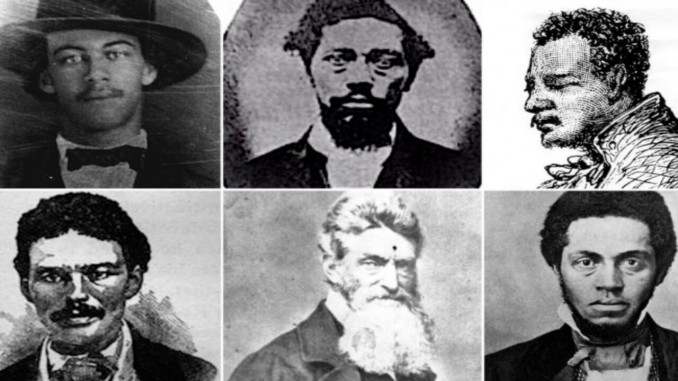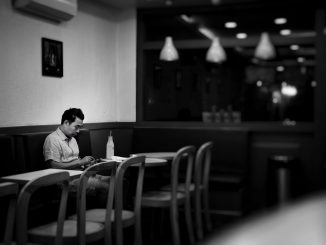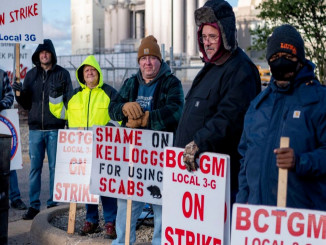
On October 16th, 1859, John Brown and eighteen of his comrades raided the U.S. Arsenal at Harper’s Ferry, West Virginia. Their aim was to spark a slave insurrection that would destroy the southern slave economy, or at the very least to accelerate the abolitionist movement in the South. Until slavery was abolished, they hoped, the revolt would allow abolitionists to help slaves escape northward, weakening the slaveholders. Although their attempt failed, the actions of Brown and his followers are a heroic example for all who fight for freedom and human dignity today.
John Brown’s sympathy with Black rights and his abolitionist views developed at an early age and were shaped by his religious upbringing and the firm belief that all people are created equal. He saw witnessed firsthand slaves were dehumanized, and despised the institution of slavery. He became part of the abolitionist movement in the antebellum North. In the 1840s, he founded the League of Gileadites, which was part of the Underground Railroad – an elaborate operation of guiding escaped slaves to freedom in Canada. He even lived for a few years in a free black farming community in North Elba, New York.
In the early 1850s, Brown decided to confront the forces of racism and slavery more directly, moving with a few of his sons to what was then called the Kansas Territory. The Kansas Territory was a newly created region slated to become a state, where a vote was to be held in which the population itself would decide by referendum whether Kansas would be a free or slave state. This situation, created by the Compromise of 1850, made Kansas a flashpoint of conflict between pro-slavery forces and abolitionists, both of whom hoped to populate the state with their sympathizers in order to have a majority when the referendum was held.
Brown not only worked to populate the state with abolitionists, but also recognized that peaceful activity would not be enough to stop the pro-slavery thugs who murdered and intimidated abolitionists. Violence simmered in the territory, and in 1856, a pro-slavery gang attacked and destroyed much of the town of Lawrence, Kansas, which had been founded by abolitionist settlers. In response, Brown and his followers attacked and killed five pro-slavery Kansans. Afterward, he and his band entered Missouri, killing a slave owner and freeing eleven slaves. These conflicts led commentators to call the region “Bleeding Kansas.”
Believing even those actions to be futile in challenging the slave system, Brown decided to undertake an action even more dramatic: seizing the U.S. military arsenal at Harper’s Ferry, West Virginia, in order to spark a wider slave revolt. Brown raised funds and tried to win supporters for his plan, including Frederick Douglass, who declined to support him as he believed the action to be suicidal, and Harriet Tubman, who helped him plan the action but was too ill to participate.
Brown carried out this daring raid in 1859. He and twenty-one comrades trained for months, making connections with slaves in nearby towns and farms, and distributing arms to them. In the evening hours of October 16, 1859, Brown and his men raided the arsenal. They quickly and quietly took possession of nearly all the buildings in the arsenal, including thousands of weapons. But a series of small yet tragic mistakes and accidents led to the plot being reported to the authorities. Soon the arsenal was surrounded by local and federal troops. Slaves in and around Harper’s Ferry – who were not fully armed and in most cases even unaware of the plan – did not rise up, leaving the rebels isolated in the arsenal. Later the next day, October 17th, General Robert E. Lee, who was later to become the commander of the Confederate Forces of the South in the Civil War, attacked the rebels, killing most of them and capturing Brown.
Brown was tried one week later and hung one month after that. He and his followers had tried and failed to begin the slave uprising that he thought would be the beginning of the end for the slave system that was feeding commodities into the expanding U.S. economy, north as well as south. But in his final letter, he predicted the coming storm of the Civil War that would finally and violently annihilate that slave system: “I, John Brown, am now quite certain, that the crimes of this guilty land will never be purged away, but with blood.” Although Brown’s Raid failed to spark the rebellion that he had hoped for, it did harden the commitment of people on both sides of debate, which led directly to the Civil War only two years later, when southern states chose to secede from the Union.
Was John Brown right to choose direct guerilla action in the fight for abolition? He made this choice after seeing that decades of peaceful work did little to abolish slavery. But the raid was carried out after only establishing a small network of supporters in the area, so when the troops arrived, Brown and his men were isolated. For a wide anti-slavery rebellion to succeed, much more organizing would have been necessary to guarantee wider support – at the very least among the Black communities of the region (both slave and free). Without this prior organizing, Brown’s action was extremely risky, as Frederick Douglass had predicted.
However, we need not agree with Brown’s tactics to celebrate his fierce commitment to the struggle for freedom and against the hellish system of slavery. He sacrificed greatly for abolition, not only in the style of life he chose to lead, but, in the end, by giving up his life. His heroism in the quest for human dignity and progress cannot be denied.
In 2021, as we see the long effects of racism and racial oppression in the United States, it is important also to recognize that the abolitionist struggle continues. Chattel slavery has been abolished, but wage-slavery persists in the form of the capitalist system. The working class majority is still forced to work for the few capitalists who own the global economy. And the capitalists use racial divisions to weaken resistance to their violent rule. As a result, the majority of Black and Indigenous people to this day are concentrated in the most oppressed and poorest layers of the working class.
John Brown and his followers stand as an example of how working people of different skin colors and backgrounds can join together and take action against the oppressing ruling classes. For that reason, we recognize John Brown’s raid as part of the long struggle to end oppression and create a just and equal world for all people.




